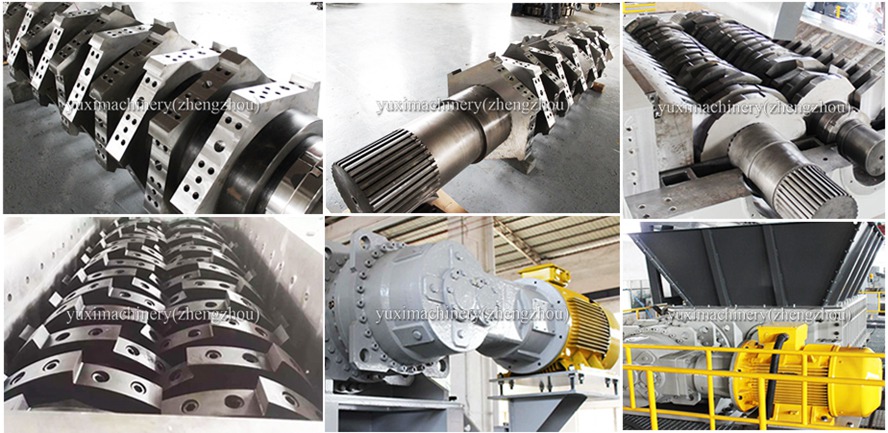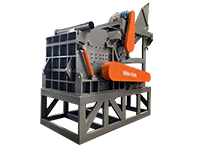In the food processing catering and recycling industries large quantities of discarded metal cans and containers often pile up not only taking up space but also potentially posing safety hazards Can shredders as professional crushing equipment are becoming key tools to solve this problem This article will delve into the working principles core advantages application scenarios and how to choose equipment that meets your needs
I Understanding Can Shredders
Can shredders are devices designed specifically for crushing metal containers using powerful mechanical force to crush and tear various metal cans barrels and tanks into small pieces Their core components include a robust body an efficient blade system and durable bearings capable of handling various metal containers from food cans to industrial barrels
Working Principle
The working principle of can shredders is based on a combination of extrusion shearing and crushing
1 Feeding system Materials enter the crushing chamber via conveyor belt or manual feeding
2 Shredding process Rotating blades work with fixed blade seats to tear materials into small pieces
3 Size control Adjust blade spacing or screen size to control the particle size of the output
4 Discharging system Shredded materials are discharged through the bottom outlet
Key Performance Indicators
• Processing capacity 1100–4400 pounds per hour depending on the model
• Shredding effect Can crush containers into uniform particles of 02–2 inches
• Energy consumption Typically ranges from 11–41 kW
• Noise control Models with soundproof enclosures can control noise below 85 dBA

II Main Advantages of Can Shredders
1 Significantly Reduce Processing Costs
Shredded metal volume can be reduced by 60–80% drastically lowering transportation and storage costs For example a chain restaurant reduced its monthly metal waste transportation costs by 70% after installing such equipment
2 Improve Recycling Efficiency
Shredded metal has higher density and more uniform particle size significantly improving the efficiency of subsequent magnetic separation and sorting A waste recycling center increased aluminum recovery by 35% after introducing the equipment
3 Enhance Safety
Sharp metal edges and unflattened containers pose safety risks during handling Shredders convert these hazards into safe particles reducing work-related injury risks
4 Environmental Benefits
By improving recovery rates and reducing transportation can shredders help reduce carbon emissions Case studies show that processing one ton of metal can reduce CO2 emissions by approximately 15 tons
III Application Scenarios and Success Stories
1 Catering Industry
A fast-food chain installed small shredding equipment in its national outlets centrally recycling shredded cans and food containers This not only reduced waste disposal costs but also generated additional revenue from selling shredded metal The company reported a payback period of less than 18 months
2 Food Processing Plants
A tomato sauce producer used large shredding equipment to process defective products and waste packaging separating shredded metal from organic waste to maximize resource utilization This reduced landfill waste by over 1000 tons annually
3 Waste Recycling Centers
A regional recycling center introduced an automated shredding line significantly improving metal processing efficiency handling over 44000 pounds of various metal containers daily and becoming a local metal recycling hub The center increased processing capacity by 50% while reducing per-ton metal processing costs

IV How to Choose the Right Can Shredder
1 Determine Processing Needs
• Processing volume How many pounds per hour need to be processed
• Material type Which metal containers will be primarily processed
• Output requirements What particle size is needed
2 Evaluate Key Performance
• Blade material High-carbon steel or alloy steel is more durable
• Motor power Sufficient power ensures stable operation
• Automation level Automation level of feeding and discharging
• Maintenance needs Replacement frequency and cost of wearing parts
3 Consider Long-Term Costs
• Initial investment vs operating costs
• Energy efficiency
• Maintenance and spare parts supply
• Equipment lifespan
4 Safety and Compliance
Ensure the equipment meets OSHA and ANSI safety standards including emergency stop devices safety interlocks and protective measures
V Frequently Asked Questions
1 Are Can Shredders Suitable for All Types of Metal Containers
Yes but for particularly thick industrial barrels or high-pressure containers choose models with corresponding shredding capabilities Most standard models handle common containers like food cans beverage cans and paint cans
2 How Are Shredded Metals Separated and Recycled
Typically magnetic separation is used for ferrous metals and eddy current separation for aluminum and stainless steel For mixed metals further manual or optical sorting may be neede
3 Does Operating Can Shredders Require Special Training
Basic operation is relatively simple but safety training is recommended especially for feeding cleaning and maintenance procedures
4 How to Ensure Long-Term Efficient Operation
Regular maintenance is key
• Inspect and replace worn blades
• Keep bearings lubricated
• Monitor motor load to avoid overloading
• Regularly clean the crushing chamber to prevent material buildup
5 What Is the Noise Level of Can Shredder
Standard models produce about 85–95 dBA; models with soundproof enclosures can reduce this to below 80 dBA Additional soundproofing may be needed for indoor use
6 What Are the Maintenance Costs of Can Shredders
Maintenance costs depend mainly on usage frequency and material type Generally blade replacement is the largest cost blades may need replacing after processing about 100000 pounds of material

Can shredders are not just tools for handling metal waste but key devices for resource recycling By choosing the right model and operating it correctly businesses can significantly reduce processing costs improve recycling efficiency and contribute to environmental protection
 Shredding Machine
Shredding Machine
 Waste Recycling Line
Waste Recycling Line
 Optional Equipment
Optional Equipment



